
MANASLU 8163M
HIGHLIGHTS
100% Manaslu 8163M Summit success, 2024,2025 Autumn expedition
North East face route
1:1 Guide/Client ratio. Small and dedicated team strategy. 1-8 max client members
Helicopter to Sama Gaun and back to Kathmandu after the expedition or trek to bc option
16 Weeks of training programs for 8000M from Training Peaks
Camp 1 - 4 strategy with rotation and rest days
OVERVIEW
Manaslu peak is the eighth-highest mountain in the world, situated in the central-west Nepal. Manaslu meaning "The Mountain of Spirits" and offers an opportunity for aspiring mountaineers to tackle an 8000-meter altitude climb for the first time.
Our expedition starts with a helicopter flight to Samagaun, a village at an altitude of 3690 meters, on the third day of the trip. After a day of acclimatization in the village, we will begin our ascent to the Manaslu base camp at 4800 meters, where our camps will have already been set up by our expedition management, Sherpa, and porter teams. The mountain has long ridges and valley glaciers that can be accessed from various directions, and its peak towers steeply above the surrounding landscape, making it a prominent feature from afar. Please see the Manaslu Expedition strategy below for more detailed information on climbing strategies.
This expedition is also a part of our “Road to EVEREST” program, Manalsu Expedition being the final preparation expedition before taking on the Big E.
Pre-requisite requirements (at least one 6000M & 7000M + multi-pitch climbing & ice climbing): Lobuche East & Island Peak, Chulu West, Khumbu 3 Peak expeditions, Mt, Blanc, Baruntse peak, Himlung Himal, Ama Dablam. (Similar 4000M - 6000M peaks or higher), multi-pitch climb (rock or ice), rock climbing grade up to 5-9+/- to 5.10 a,b,c, and Ice climbing WI-3 to WI-4.
-
USD 22,500 P/P - Signature climb
USD 19,950 P/P - Classic+ PLUS climb
USD 16,500 P/P - Classic climb
Deposit: USD 3,000 required
Please inquire about prices in your local currency. We accept payment in £GBP/ €EUROS/ $AUD
-
Autumn 2026
6th September - 5th October - Signature climb
1st September - 5th October - Classic+ PLUS
1st September - 9th October - Classic climb
Autumn 2027
6th September - 5th October - Signature climb
1st September - 5th October - Classic+ PLUS
1st September - 9th October - Classic climb
Autumn 2028
6th September - 5th October - Signature climb
1st September - 5th October - Classic+ PLUS
1st September - 9th October - Classic climb
-
IFMGA or NNMGA certified Guide leader
Namas Branded merchandise (Down Jacket, Cap, Buff)
1:1 Sherpa/client ratio. (Additional Sherpa can be arranged, extra charges apply)
16 Weeks of training programs for 8000M fromTraining Peaks
Head chef and kitchen helpers (Helpers increase with the number in climbing team members)
2 nights before the expedition and 1 day after the expedition. 5 Hotel in Kathmandu. Single room. (Should clients return early from their expedition, clients will be responsible for their extra Kathmandu hotel bookings)
2 Nights luxury stay in Nagarkot. 90 min Massage session, breath-work session, foot massage reflexology & facial, after expedition. (Sauna included)
All trekking and climbing permits (Manaslu Region Permit and TIMS)
All internal-local transportation to and from the trekking trailhead
Expedition tents (2 tents) Brands Salewa, Mountain Hardwear, Samaya equipment, Kailas
4 Oxygen Bottles
60 kgs personal weight
🚁 Helicopter to Sama Gaun and back to Kathmandu after expedition
Chocolate, energy bars, hydration pills, biscuits, canned foods, nuts
Burners and expedition equipments
Walkie-talkie/ Satellite phone
Breakfast, Lunch, and Dinner on trek and expedition days.
Lodge accommodation during the trek
Porters per guest
Arrival pick-up and departure
Basic First aid kit
Welcome/Farewell leave Dinner
-
NNMGA certified Guide leader
Namas Branded merchandise (Down Jacket, Cap, Buff)
1:1 Sherpa/client ratio. (Additional Sherpa can be arranged, extra charges apply)
16 Weeks of training programs for 8000M fromTraining Peaks
Head chef and kitchen helpers (Helpers increase with the number in climbing team members)
2 nights before the expedition and 1 day after the expedition. 5 Hotel in Kathmandu. Single room. (Should clients return early from their expedition, clients will be responsible for their extra Kathmandu hotel bookings)
90 Min massage session after the expedition (Kathmandu)
All trekking and climbing permits (Manaslu Region Permit and TIMS)
All internal-local transportation to and from the trekking trailhead
Expedition tents (2 tents) Brands Salewa, Mountain Hardwear, Samaya equipment, Kailas
3 Oxygen Bottles
60 kgs personal weight
Trek to Sama Gaun and back to Kathmandu after expedition via helicopter 🚁
Chocolate, energy bars, hydration pills, biscuits, canned foods, nuts
Burners and expedition equipments
Walkie-talkie/ Satellite phone
Breakfast, Lunch, and Dinner on trek and expedition days.
Lodge accommodation during the trek
Porters per guest
Arrival pick-up and departure
Basic First aid kit
Welcome/Farewell leave Dinner
-
NNMGA certified Guide leader
Namas Branded merchandise (Down Jacket, Cap, Buff)
1:1 Sherpa/client ratio. (Additional Sherpa can be arranged, extra charges apply)
Head chef and kitchen helpers (Helpers increase with the number in climbing team members)
2 nights before the expedition and 1 day after the expedition. 4 Hotel in Kathmandu. Single room. (Should clients return early from their expedition, clients will be responsible for their extra Kathmandu hotel bookings)
All trekking and climbing permits (Manaslu Region Permit and TIMS)
All internal-local transportation to and from the trekking trailhead
Expedition tents (2 tents) Brands Salewa, Mountain Hardwear, Samaya equipment, Kailas
2 Oxygen Bottles
45 kgs personal weight
Trek in and out
Chocolate, energy bars, hydration pills, biscuits, canned foods, nuts
Burners and expedition equipments
Walkie-talkie/ Satellite phone
Breakfast, Lunch, and Dinner on trek and expedition days.
Lodge accommodation during the trek
Porters per guest
Arrival pick-up and departure
Basic First aid kit
Welcome/Farewell leave Dinner
-
Visas and travel insurance
Summit Bonus Tip ($1500 Per member)
Entertainment and food ( Kathmandu )
Bottled drinks and beverages
Evacuation (will be done in your account)
Single supplement Charges
Laundry, Phone services, Personal expenditure transactions
Optional trips
Tea breaks, chocolates or other snacks, and any meals besides breakfast, lunch, and dinner.
Delay and cancellation because of natural phenomenon
International flights to Kathmandu
-
2024 Fall season. Summit by NAMAS team. 4 Members summited.
🗓️ 25.09.2024 - 4 X members
-
Helicotper Samagau to Kathmandu: USD 2500
Manaslu + Annapurna 4 7525M - Please inquire
Manaslu + Ama Dablam 6812M - Please inquire
ITINERARY - Signature climb
Day 1 Arrival, Airport pick up by Namas members
Day 2 Briefing and equipment review at hotel in Kathmandu, last minute shopping, group dinner. Stay at a hotel.
Day 3 🚁 Fly to SamaGaun, 3,690 meters (12,106 feet)
Day 4 - 5 Rest in SamaGaun. Acclimatization, re-packing, and preparation for Expedition.
Day 6 - 8 Hike to Basecamp. Acclimatization, training (Crampon works/Abseil/climb Fixed line/Ladder climbing training), and Puja (Ceremony)
Day 9 - 17 Camp 1 - 3 Rotations
Day 18 - 19 Rest in base camp. Acclimatise Regain strength.
Day 20 - 26 Summit Bid. Trek to Samagaun (with contingency days)
Day 27 - 28 🚁 Fly to Kathmandu from Samagaun. Nagarkot - NAMAS Signature Reset & Recover
Day 29 Kathmandu
Day 30 Departure or Further extend your stay in Nepal
*Schedule subject to change based on route conditions, weather conditions, and climber health.
-
Day 27 — Physical Reset & Nervous-System Downshift
Arrival - Silent check-in & welcome ritual (no briefings, no schedules)
Deep tissue / sports recovery massage (60–90 mins) - Focus: calves, quads, hips, lower back, shoulders
Infrared or traditional sauna session
Guided breath work session (20–30 mins) - Helps shift from survival mode to recovery mode
Day 28 — Mental Closure & Gentle Reawakening
Slow wake-up with sunrise Himalayan views
Guided mindfulness or reflection session → closing the climb mentally, not just physically
Foot therapy / reflexology and Facial
Guided breath-work session (20–30 mins) - Helps shift from survival mode to recovery mode
-
Day 1 - 2 Arrival day in Kathmandu (1,300m/4,264ft) and briefing
Day 3 Drive to Soti Khola (710m/ 2,330ft)
Day 4 Trek to Machha Khola (900m/ 2,953 ft)
Day 5 Trek to Jagat (1,410m/ 4,626ft)
Day 6 Trek to Deng (1,804m/ 5,919ft)
Day 7 Trek to Namrung (2,630m/ 8,629ft)
Day 8 Trek to Samagaon (3,530m/ 11,582 ft); meet the rest of the team
Day 9 - 10 Rest in SamaGaun. Acclimatization, re-packing, and preparation for Expedition.
Day 11 - 13 Hike to Basecamp. Acclimatization, training (Crampon works/Abseil/climb Fixed
line/Ladder climbing training), and Puja (Ceremony)
Day 14 - 22 Camp 1 - 3 Rotations
Day 23 - 24 Rest in base camp. Acclimatise Regain strength.
Day 25 - 33 Summit Bid. Trek to Samagaun (with contingency days)
Day 34 🚁 Fly to Kathmandu from Samagaun
Day 35 Departure or Further extend your stay in Nepal
-
Day 1 - 2 Arrival day in Kathmandu (1,300m/4,264ft) and briefing
Day 3 Drive to Soti Khola (710m/ 2,330ft)
Day 4 Trek to Machha Khola (900m/ 2,953 ft)
Day 5 Trek to Jagat (1,410m/ 4,626ft)
Day 6 Trek to Deng (1,804m/ 5,919ft)
Day 7 Trek to Namrung (2,630m/ 8,629ft)
Day 8 Trek to Samagaon (3,530m/ 11,582 ft); meet the rest of the team
Day 9 - 10 Rest in SamaGaun. Acclimatization, re-packing, and preparation for Expedition.
Day 11 - 13 Hike to Basecamp. Acclimatization, training (Crampon works/Abseil/climb Fixed
line/Ladder climbing training), and Puja (Ceremony)
Day 14 - 22 Camp 1 - 3 Rotations
Day 23 - 24 Rest in base camp. Acclimatise Regain strength.
Day 25 - 33 Summit Bid. Trek to Samagaun (with contingency days)
Day 35 Samagau to Bhimthang
Day 36 Bhimthang to Dharapani
Day 37 Dharapani to Besisahar by Jeep
Day 38 Besisahar to Kathmandu
Day 39 Departure
-
-
3317 Summits
-
Manaslu was first climbed on May 9, 1956, by Toshio Imanishi and Gyalzen Norbu, members of a Japanese expedition.
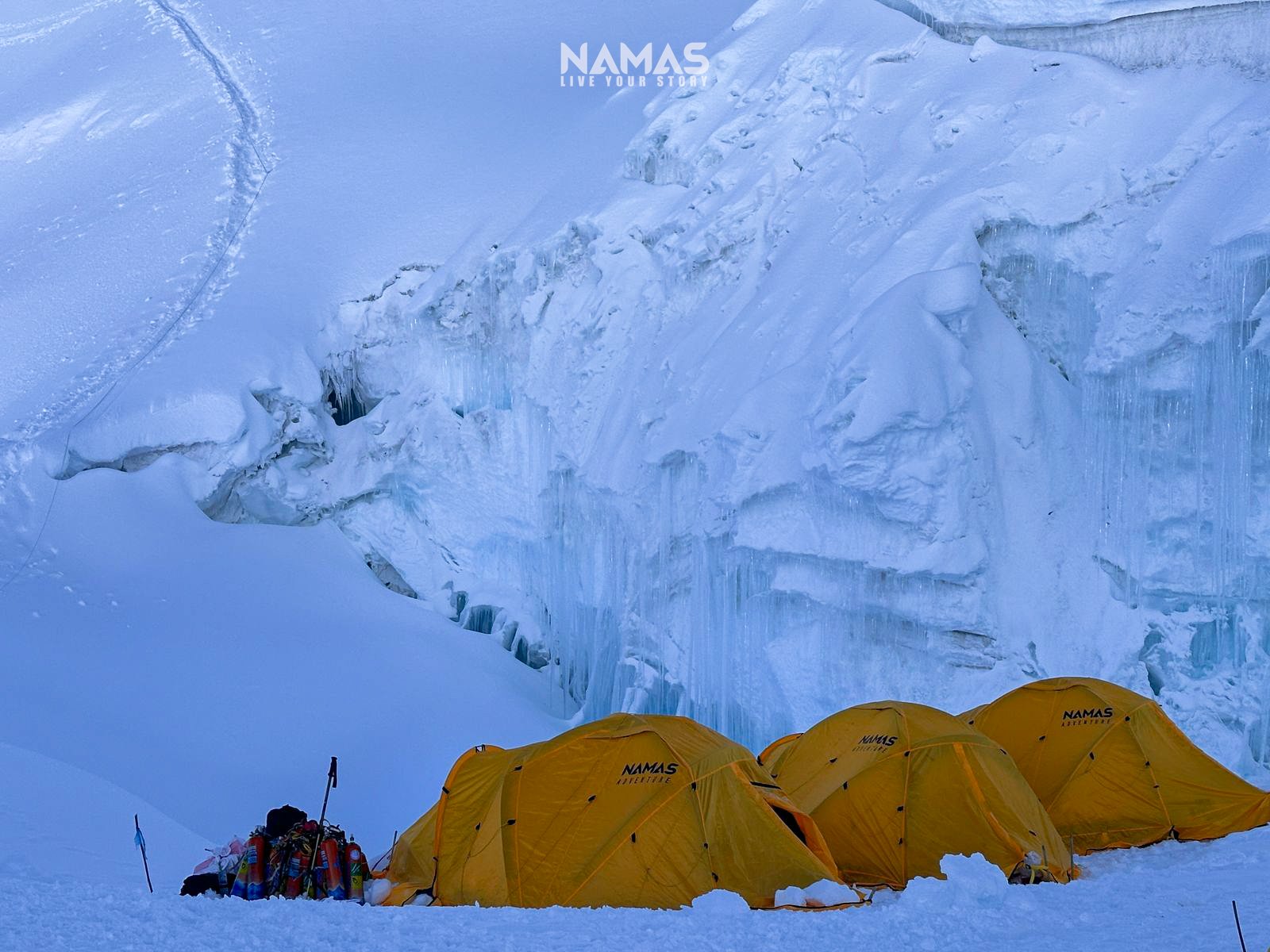
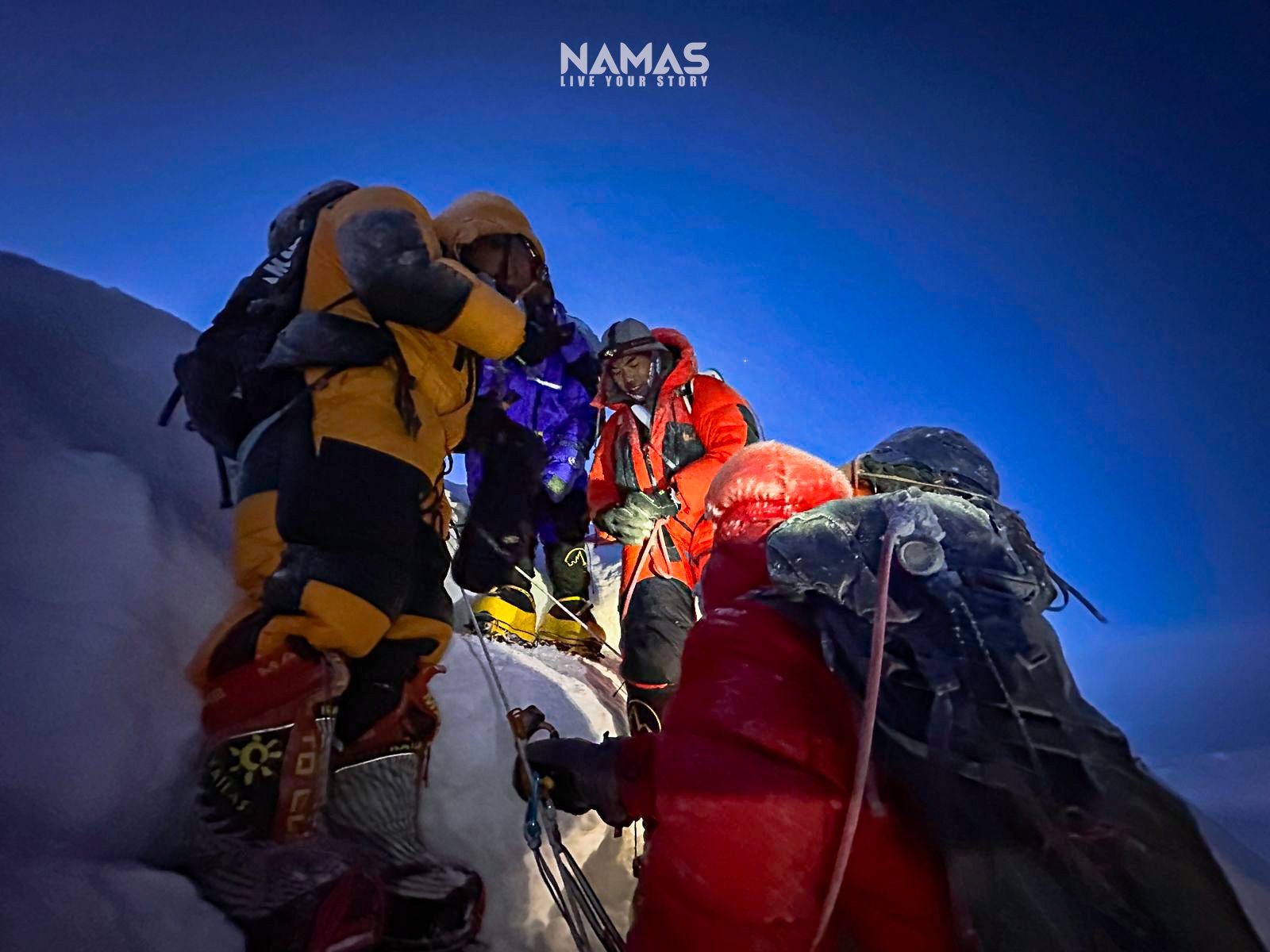
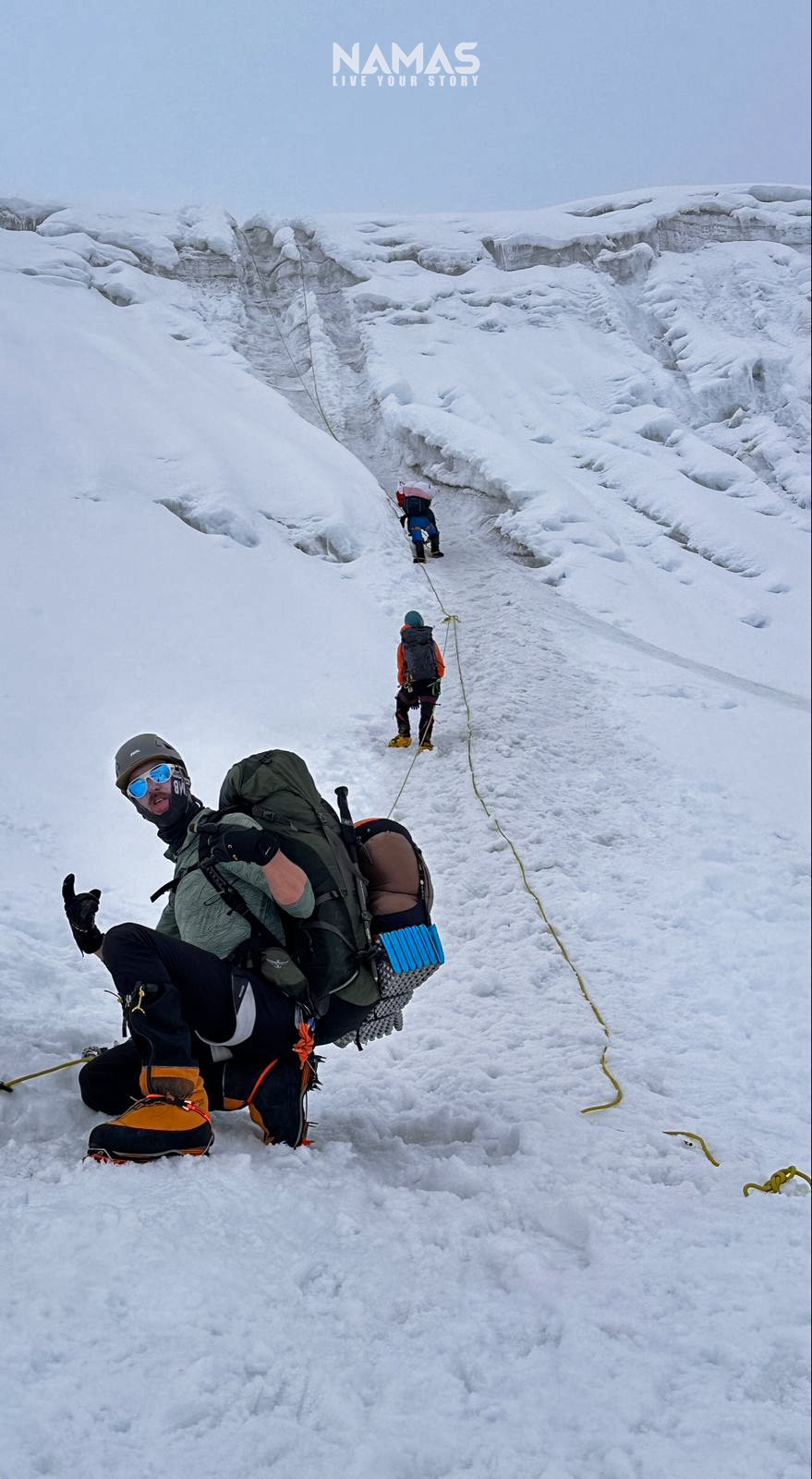
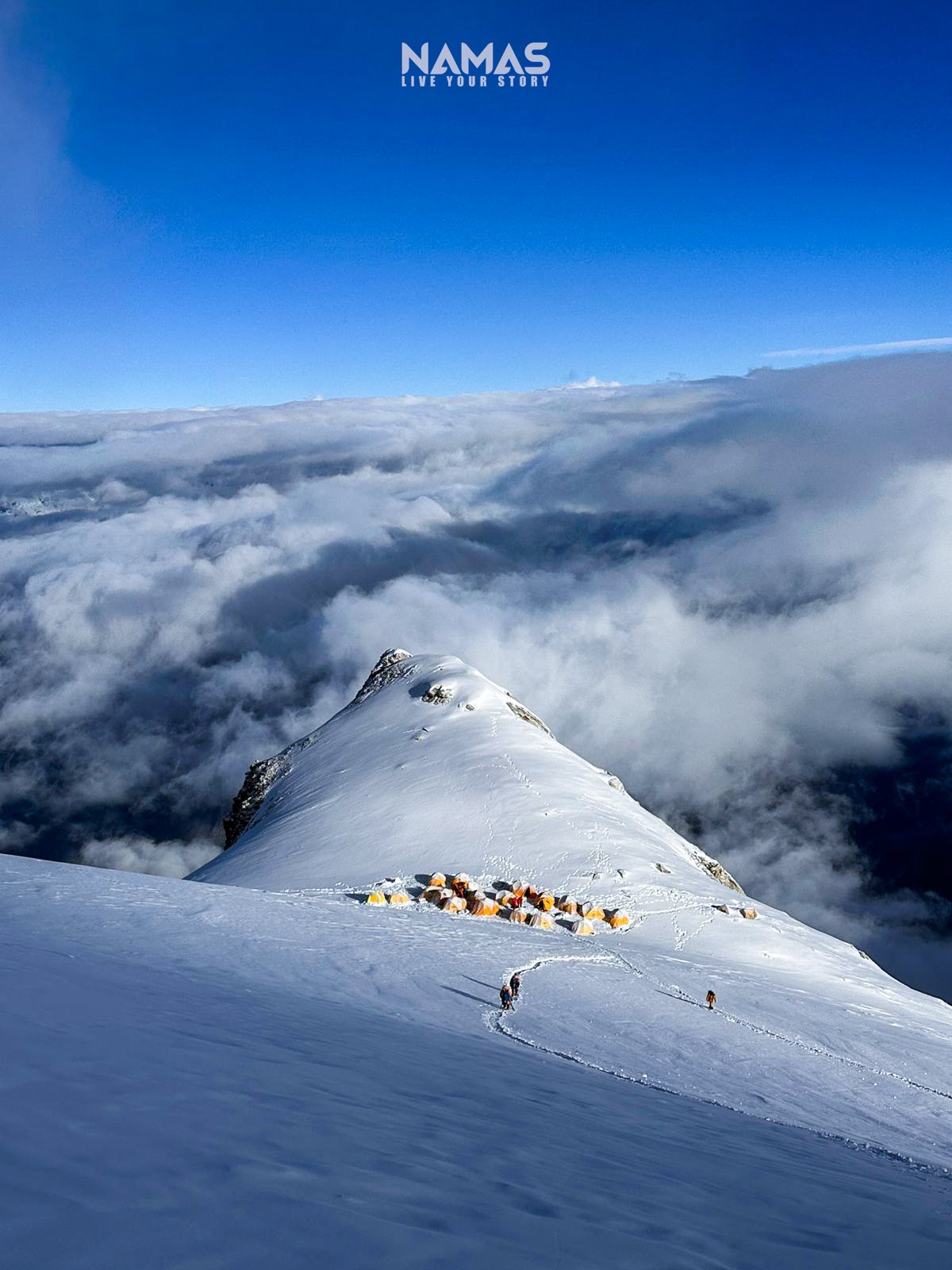
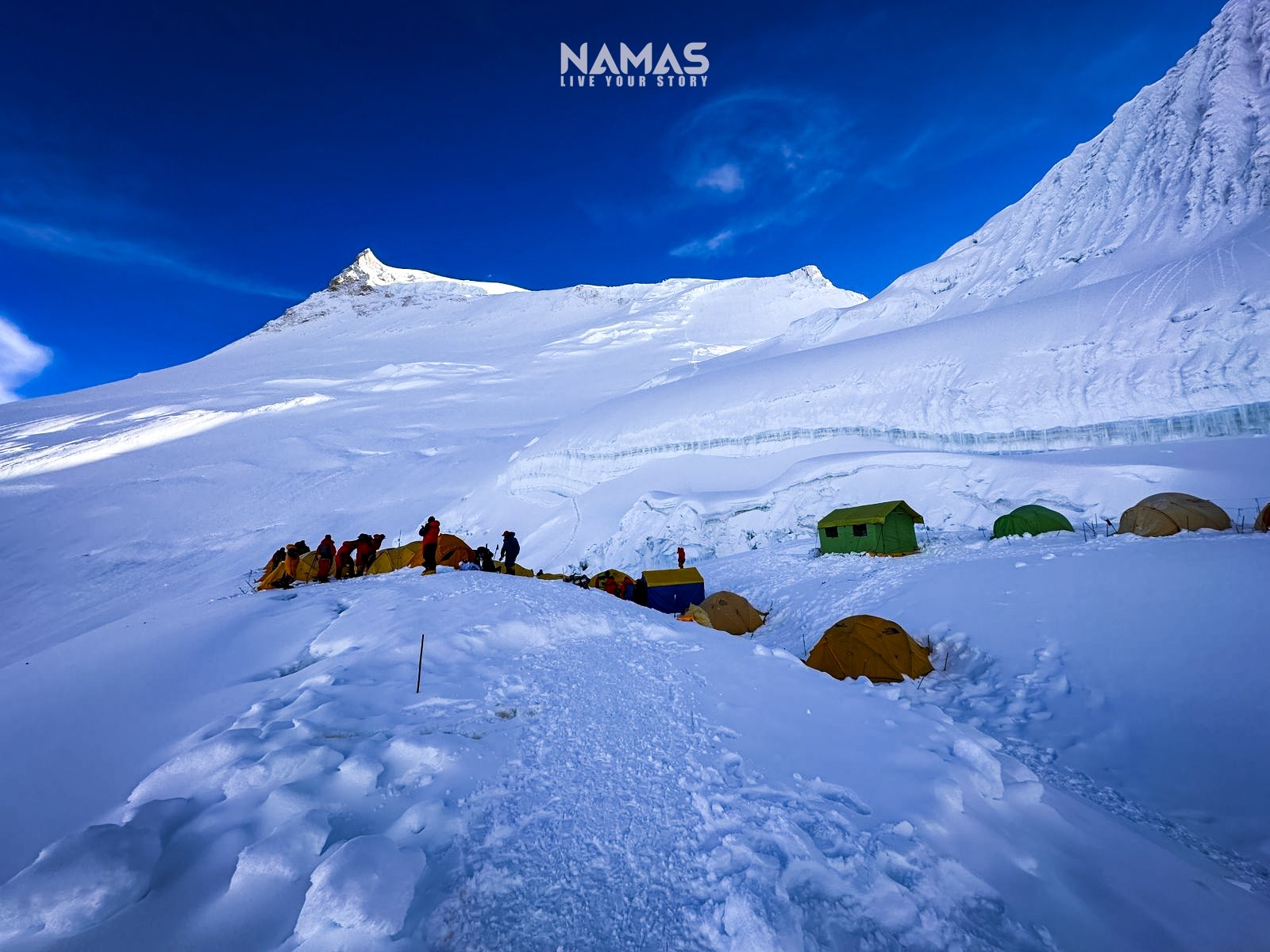
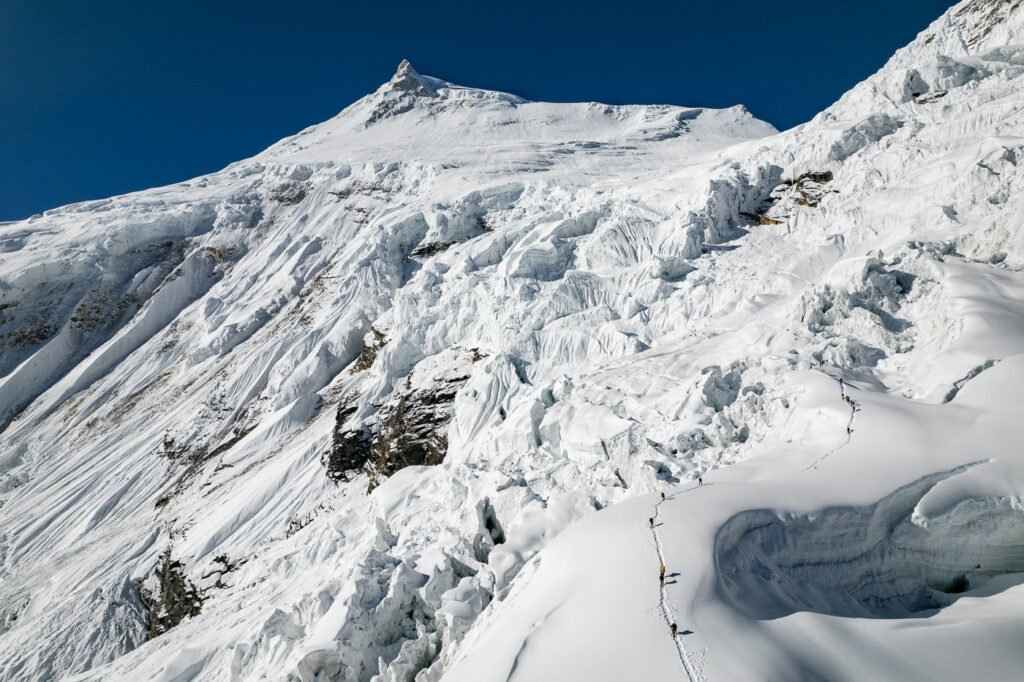
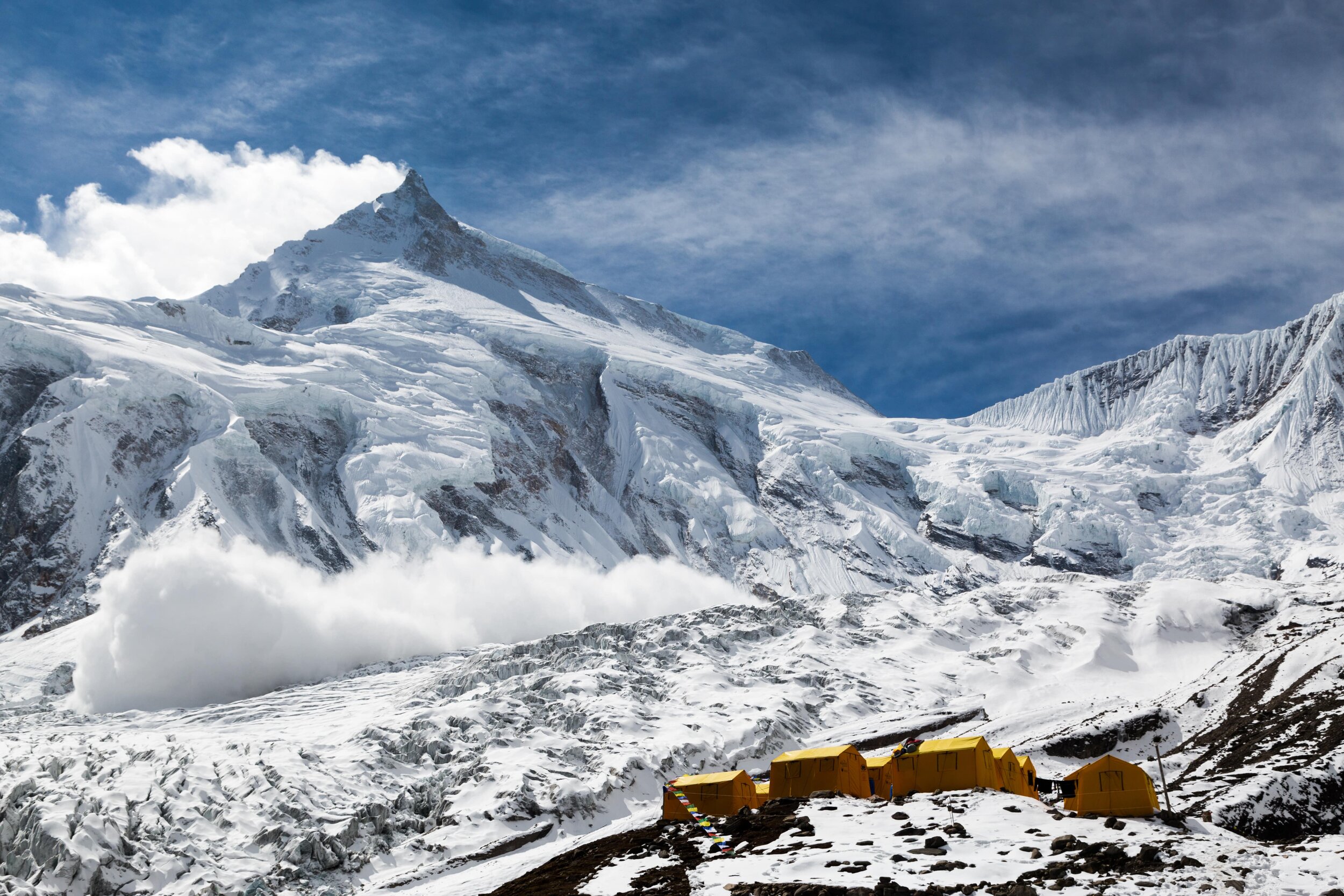

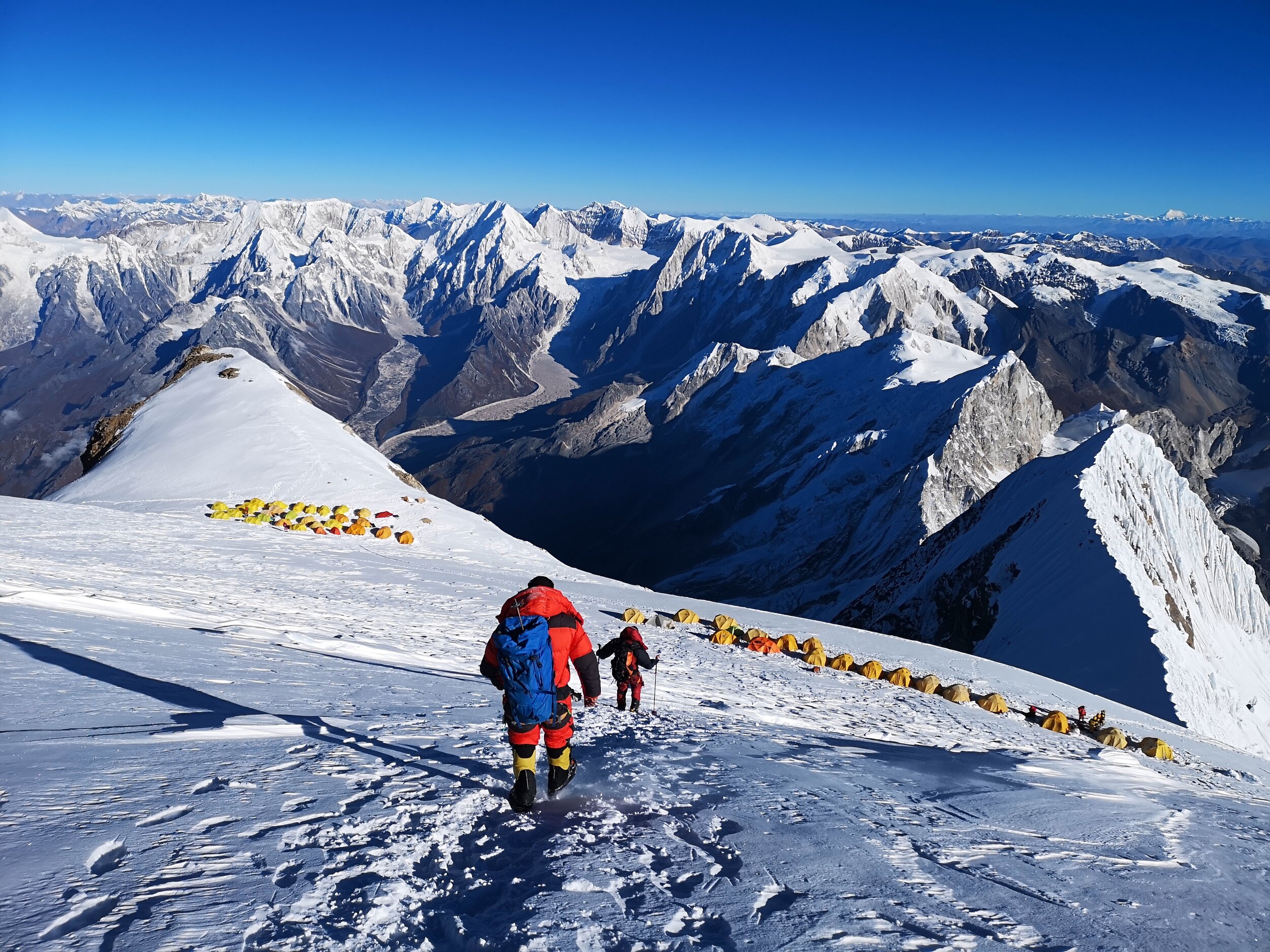
HOW DOES IT WORK?
1. Initial Inquiry and Planning
At NAMAS Adventure, we start by understanding your aspirations and goals. From your first conversation with our expert team, we provide personalized recommendation tailored to your interests. Once the perfect expedition is identified, a deposit secures your spot. We then work closely with you to plan and prepare every detail—from gear selection and training advice to arranging insurance, permits, and logistics.
2. Preparing for the Journey
As your expedition date approaches, we’ll help you finalize all preparations. This includes collecting the final balance payment (typically due 60-90 days before your trip), ensuring all necessary documents are in order, and addressing any remaining questions. Our team is available via email or phone calls to make sure you’re fully prepared and confident for the adventure ahead.
3. On-Expedition Support
Arrive at your destination ready to begin! From pre-expedition briefings and gear checks to the full support of our experienced guides and ground team during your climb, we’re here to ensure everything runs smoothly. With flexibility to adapt to any changes or needs, we’re committed to making your adventure seamless, enjoyable, and unforgettable

STRATEGY
Base Camp 4800M to Camp 1 (5600M - 5700M)
On the third day of our expedition, we will take a Jeep - trek or helicopter flight from Kathmandu to Sama Gaun, a village at an altitude of 3690 meters. After acclimatizing for a day in the village, we will begin our hike to the Manaslu base camp at 4800 meters, where our camps will have already been set up by our expedition management, Sherpa, and porter teams.
The base camp will serve as our home for the next 25-28 days, and preparations for the climb will have been completed months in advance. Our team will be ready to welcome clients, providing them with a comfortable place to eat, rest, relax, and have fun. We will ascend the mountain via the North-East Face, using four camps along the way. After a few days of acclimatization, training, and a puja ceremony, our group will head to camp 1. The climbers will follow a rugged uphill path that takes them through a moraine and a crevassed glacier to reach camp 1. The views from the base camp are breathtaking, with the Himalayas dominating the landscape in all directions.
Camp 1 (5600M - 5700M) - Camp 2 (6300M - 6400M)
The climb from Camp 1 to Camp 2 is a challenging and strenuous ascent that involves ascending moderate-angled snow slopes on the lower reaches and a short steep slope above Camp 1.
This section of the climb requires full focus and may take anywhere from 5 to 7 hours or more, depending on the individual climber. Upon arrival at Camp 2, located at an altitude of 6300-6400 meters, climbers will be treated to breathtaking views of the surrounding Himalayan peaks. From this vantage point, the surrounding mountains will feel close enough to touch.
Camp 2 (6300M - 6400M) - Camp 3 (6900M)
The route from Camp 2 to Camp 3 involves steady progress on snowy slopes, with a short but steep section just before arriving at the camp. The climb will take approximately 4-5 hours to complete.
This day's ascent is relatively straightforward, with no major obstacles to overcome.
Camp 3 (6900M) - Camp 4 (7300M)
The route from Camp 3 to Camp 4 involves climbing a steep, vertical slope using fixed ropes and crampons to reach an altitude of 7300 meters. This part of the climb will take approximately 6-7 hours to complete. In order to acclimatize effectively, we will frequently rotate between higher and lower camps before making the final push to the summit.
This strategy helps ensure that our bodies are properly adjusted to the high altitude and reduces the risk of altitude sickness.
Camp 4 (7300M) - Summit 8163M to Camp 2 (6300M - 6400M)
The journey from Camp 4 to the summit is less technical than the previous sections, but longer and requires more steady progress over a flowing snowy/icy slope. The views during this part of the climb are incredible, as climbers make their way to an altitude of 8000 meters.
After approximately 6-8 hours of climbing, the team will arrive at the "false summit," where many operators choose to end their ascent. However, the Namas Expedition Sherpa team will always aim to fix the rope to the "true summit," the highest point of Manaslu at 8163 meters. This requires careful planning and decision-making due to the unstable nature of the ice/snow surface at the summit.
Descending the mountain is a relatively straightforward process, but equal care must be taken as climbers will be extremely tired after reaching the summit. Our main objective will be to safely reach Camp 2 by the afternoon or early evening hours. The following day, we will descend from Camp 2 to the base camp, which should take 3-4 hours. Our base camp team will be waiting to welcome us with cheers and celebration for our successful summit. After resting for a bit, we will enjoy a well-deserved warm meal prepared by our chef.
The return journey involves the same trek back down to Sama Gaun, followed by a night in the village before catching a helicopter back to Kathmandu. Upon arriving in Kathmandu, climbers will have an additional two nights for rest, showers, and celebrations before returning home.
Frequently Asked Questions
-
September to November (Autumn).
This is the prime season for Manaslu because weather windows and route stability are typically at their best. You still need flexibility—Manaslu is an 8,000m mountain and the summit window is never guaranteed. -
Our strategy is built around efficiency, fixed-line systems, and disciplined pacing. Our rope-fixing team establishes fixed lines on the critical sections so the team can move safely and reduce wasted time and energy.
Camp progression:
Camp 1 - 5,600M
Camp 2 - 6,300M
Camp 3 - 6,900M
Camp 4 - 7,300M
Summit Push 8163M
Manaslu is considered less technical than some 8,000m peaks, but it is still the Death Zone. If you treat it casually, it will punish you.
-
Summit day is generally a straightforward line compared to steeper 8,000m peaks, often along a narrow ridge with sustained snow/ice travel.
We usually start early (often pre-dawn), summit, and descend the same day—commonly back to Camp 2 or BC if conditions and strength allow. The key is controlled pacing and clean systems. Speed without discipline is how accidents happen.
-
Yes. We build contingency into the climbing phase.
In excellent conditions, the full Base Camp → Summit → return sequence can happen in 10–15 days. But Manaslu does not always cooperate. We typically include 4 additional contingency days to wait for a safe summit window or adjust plans when conditions shift.
We strongly recommend booking flexible return flights. Fixed schedules create pressure—and pressure is dangerous at 8,000m.
Team, Ratios, Logistics & Training
-
Lead guide: IFMGA / NMA certified (depending on expedition leadership structure)
Sherpa ratio: 1:1 Sherpa-to-client
Sherpas trained through Nepal’s professional systems (Khumbu pathway / NMA/NNMGA aligned training)
English: typically intermediate, strong enough for instruction and clear safety communication under stress
Additional personal Sherpa support can be arranged if requested (additional cost).
-
Most guests tip at the end of the expedition.
$1000 Summit bonus to personal guide
USD 250 tip pool for kitchen team
Gear donations and a final team dinner are also common gestures of appreciation.
-
Manaslu is often considered a “less technical” 8,000m climb—but it is still a serious Death Zone expedition. You need fitness, consistency, and functional systems.
Key skills:
Abseiling / rappelling (multi-pitch experience is a major advantage)
Movement on varied terrain: slabs, steeper rock, scrambling
Crampons + ice axe competence, including confident descending
Self-arrest fundamentals
High-altitude self-management: pacing, hydration, eating, recovery
Preferred experience: prior high-altitude climbing 4,000m–7,000m+. The more altitude time you have, the less the mountain surprises you.
-
We run 1:1 Sherpa guiding for climbers, plus expedition leadership and support staff scaled to team size.
-
Min 1 – Max 8.
-
Climbers from around the world. Some come for their first 8,000m. Others come after Everest or another 8,000er. Different mountains. Different problems. Same requirement: discipline.
-
You need to be in excellent shape. Sherpa support is strong, but you must still carry your own personal kit during rotations and be able to perform consistently for weeks.
What technical preparation and training should I do?
We recommend:
basic bouldering / rope climbing sessions
consistent endurance + strength training
a basic ice climbing / mountaineering course
a prior 4,000m–6,500m summit (or higher) to validate altitude response
-
Manaslu packages typically include 2 bottles of oxygen, plus oxygen as a medical backup. Additional bottles can be arranged upon request (extra cost).
-
Yes. Once you enquire/confirm, we send a detailed list and help you validate your kit.
Insurance, Visas
-
Mountaineering insurance is mandatory. You need coverage for:
high-altitude mountaineering
medical treatment
rescue/evacuation
trip interruption/cancellation (strongly recommended)
Evacuation insurance - Yes. Non-negotiable.
Trip cancellation insurance protects your investment if you must cancel due to injury, illness, or serious unforeseen events (family, work, emergencies). On an 8,000m expedition, it’s not optional “nice-to-have”—it’s smart risk management.
-
Most nationalities can obtain a visa on arrival. Ensure passport validity and bring the required cash/photos as per current requirements.



